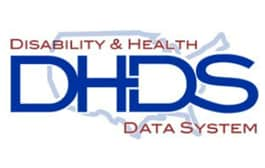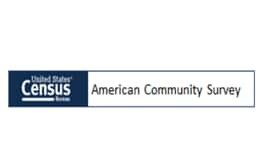| Population: |
Adults |
| Numerator: |
Adults who said yes to at least one of six disability questions related to serious difficulty including (1) hearing, (2) vision, (3) concentrating, remembering, or making decisions (i.e., cognition), (4) walking or climbing stairs (i.e., mobility), (5) dressing or bathing (i.e., self-care), and (6) doing errands alone (i.e., independent living). |
| Denominator: |
All adults |
| Measure: |
Prevalence (crude and age-adjusted) |
| Time Period of Case Definition: |
Current |
| Summary: |
In 2020, one in four U.S. adults reported having at least one of the following disability types: hearing, vision, cognition, mobility, self-care, and independent living.1 Disability prevalence increases with age (18–44 years, 18.4%; 45–64 years, 26.7%; and 65 years and older, 41.6%).1 To be healthy, all individuals with or without disabilities must have opportunities to take part in meaningful daily activities that add to their growth, development, fulfillment, and community contribution. Assessment of disability highlights opportunities and areas for improvement for people with disabilities, including opportunities to fully participate in and benefit from public health activities, receive well-timed interventions and services, interact with their environment without barriers, and participate in everyday life activities.2 |
| Notes: |
The six-item disability standard series of questions represents a uniform data collection standard for inclusion in surveys conducted or sponsored by HHS as required by the Affordable Care Act.3 The six questions may provide a conservative prevalence estimate in that some questions emphasize “serious” difficulty doing functions, thus potentially excluding individuals with less severe impairments.4 Prevalence estimates of disability have been shown to vary across surveys with differences attributed to several factors, including survey context, assessment, design, and administration.5 |
| Data Source: |
Behavioral Risk Factor Surveillance System (BRFSS) |
| Related Objectives or Recommendations: |
None |
| Related CDI Topic Area: |
None |
| Reference 1: |
National Center on Birth Defects and Developmental Disabilities, Centers for Disease Control and Prevention. Disability and Health Data System (DHDS). Accessed October 31, 2022. https://dhds.cdc.gov |
| Reference 2: |
Healthy People 2020, National Center for Health Statistics. Healthy People 2020 Midcourse Review: Chapter 9: Disability and Health (DH). Centers for Disease Control and Prevention, US Dept of Health and Human Services. https://www.cdc.gov/nchs/data/hpdata2020/hp2020mcr-c09-dh.pdf |
| Reference 3: |
US Department of Health and Human Services. Implementation guidance on data collection standards for race, ethnicity, sex, primary language, and disability status. Rockville (MD): US Department of Health and Human Services; 2011. Accessed March 8, 2023. http://aspe.hhs.gov/datacncl/standards/ACA/4302/index.shtml |
| Reference 4: |
McGuire DO, Watson KB, Carroll DD, Courtney-Long EA, Carlson SA. Using Two Disability Measures to Compare Physical Inactivity Among US Adults With Disabilities. Prev Chronic Dis. 2018 Jan 18;15:E08. doi: 10.5888/pcd15.170261. |
| Reference 5: |
Lauer EA, Houtenville AJ. Estimates of prevalence, demographic characteristics and social factors among people with disabilities in the USA: a cross-survey comparison. BMJ Open. 2018; 8:e017828. doi: 10.1136/bmjopen-2017-017828. |



